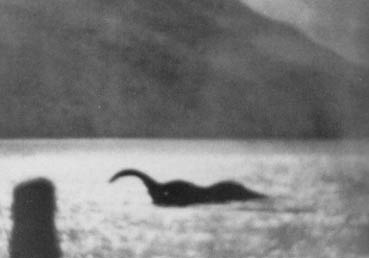John Gillies's Loch Ness Monster photo and the plesiosaur Cryptocleidus oxoniensis.
Comparisons and captions are Scott's. I should note that the museum mount is missing its teeth. I remarked that the underwater head had something of the look of a sock puppet before (but that I had heard of Sea Serpent cases where it was supposed to look like that) Scott remarked that Doc Shiel's Loch Ness Monster phoro also looked like a sock puppet: maybe front-on and in life, Plesiosaurs looked something like a muppet in the face.The museum mount skull has that same look.
One of the clearest photos of the Loch Ness monster was taken by Anthony 'Doc' Shiels in May of 1977. The picture is so clear, however, it immediately makes experts skeptical and has been referred to in some circles as "the Loch Ness Muppet." Shiels himself, a self-styled physic, has said that while he definitely takes photos of lake monsters, he doesn't believe in them. The UnMuseum http://www.unmuseum.org/lochness.htm
Image credit: © Anthony Shiels (Original above, modified cropped below)
Uploader comment: The Doc Shiels picture reversed and stretched horizontally, this is the same image and not a second of a series.
Image status: UNEXPLAINED This famous photograph taken by Anthony 'Doc' Shiels in 1977 was allegedly taken near Urquhart Castle. While never proven as a hoax the clarity of the picture calls its authenticity in to doubt.

nessie muppet photo-2, Dale attempts to replicate the effect with photoshop experiment
With more elongated views a Postorbital skull opening (on top in the rear of the head)
can be seen directly behind the eye socket (o) and this arrangement is typical of Plesiosaurs
 |
| Doc Shiel's reconstruction of creature in the photo: he thought it was an invertebrate |
http://newpagebooks.blogspot.com/2012_09_01_archive.html
Alternative view of Nessie as an invertebrate
Model of the Loch Ness Monster ashore based on the drawing of the creature ashore, as drawn by witness [ Sketch by Margaret Munroe of the animal she saw on
Morgawr, Cornwall, and Lough Muck Monster, Ireland
Both of them supposedly photos mailed in to Doc Shiels by unknown photographers
who wished to remain anonymous

Academy of Applied Sciences "Gargoyle Head" and "Flipper" photos,
taken at Loch Ness in the mid-1970s
The theory of Oberon Zell is based on a completely imaginary invented animal. nothing remotely like it exists in nature now nor yet in the fossil record. And the key flaw is, as Bernard Heuvelmans pointed out when the theory started circulating in the 1960s, is that such an enormous body mass requires an internal skeleton, and the internal skeleton is what gives these creatures their distinctive head and flipper shapes (photographs top and bottom on this blog) This is also why Roy Mackal abandoned the GGiant sea slug theory in his book Loch Ness Monster. It is my contention that the internal skull and skeleton is Plesiosaurian and the creature must be regarded as Plesiosaurian: Scott is concurring with me in this. And while I don't insist on the "Gargoyle head" or "Muppet" pghotographs as closely approximating what they look like, Scott does, and he thinks these photos also tend to reinforce the theory.












To "Joe Richardson"-Once again, if you have comments to direct to Scott Mardis please make them to Scott Mardis
ReplyDeletehttps://www.facebook.com/scott.mardis.5
And he can discuss your problems there. I will not presume to make any answers on his behalf.